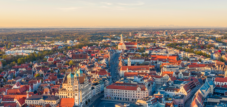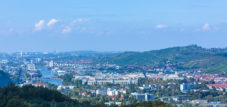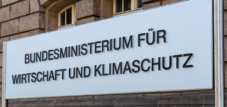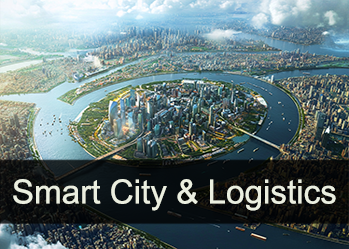Climate analysis Frankfurt: The master plan 100% climate protection and the impact of climate change with strategy
Language selection 📢
Published on: July 30, 2023 / update from: August 4, 2023 - Author: Konrad Wolfenstein
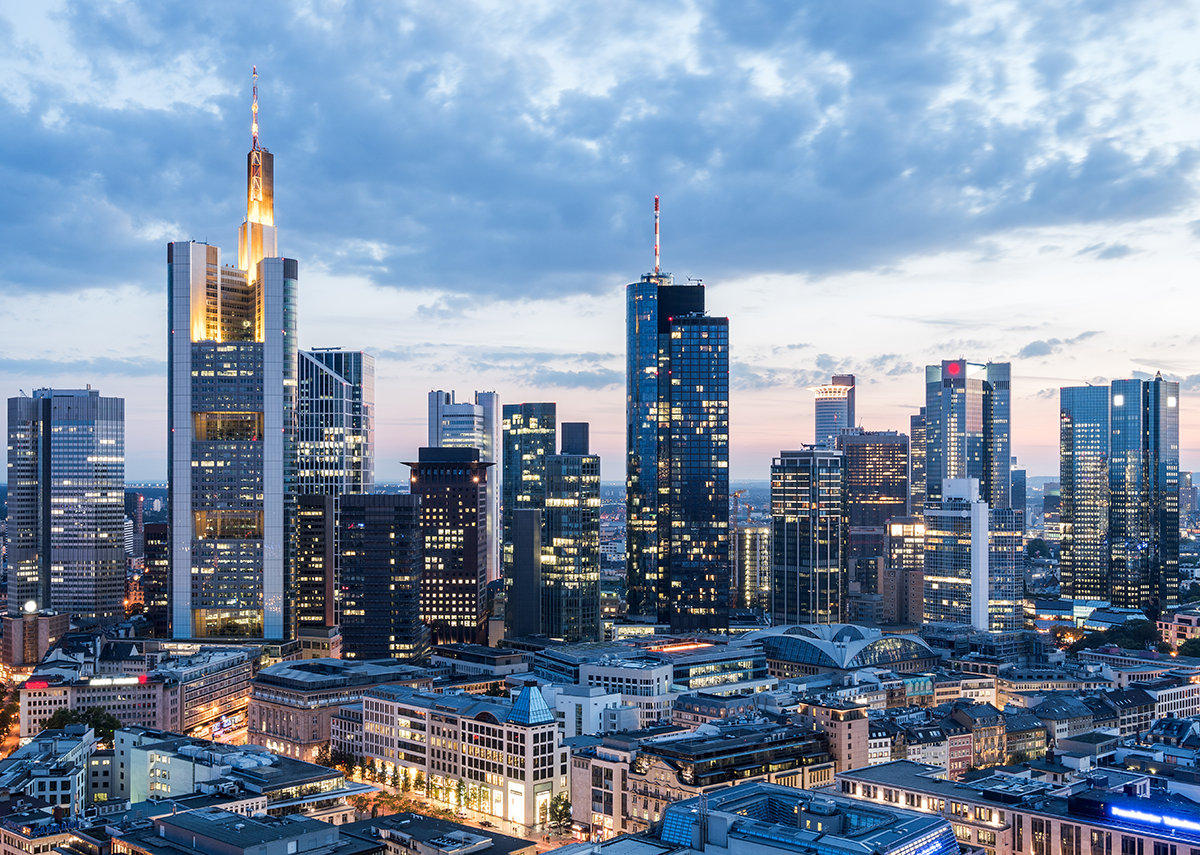
Frankfurt: Impact of climate change and strategies for the future – Image: engel.ac|Shutterstock.com
Climate change in Frankfurt am Main: Preventive measures for a heat-resistant city
➡️ The “Smart Columbarium” as an innovative solution
Given the predicted increase in heat stress in Frankfurt am Main, urgent preventive measures must be taken to protect the well-being of the population and maintain the urban infrastructure. Various approaches and innovative ideas are presented here on how Frankfurt can become a heat-resistant city to meet the challenges of climate change.
Green areas and shaded areas: Natural air conditioning in the city
The creation and maintenance of green spaces within the city play a crucial role in reducing heat stress. Trees and plants not only provide pleasant shade for passers-by, but also cool the environment through evaporation effects. It is important that the city administration focuses more on planting streets, squares and roofs in order to mitigate the summer temperatures in the city. Green spaces also help to improve air quality and promote the general well-being of residents, which is particularly important on hot days.
Create cool oases: Refreshing retreats in built-up areas
Creating cool oases is particularly important in heavily built-up areas. Public parks with shady seating and water features offer people protection from the heat and invite people to linger. Such retreats allow residents to escape the oppressive heat of the city and refresh themselves. These cool places are a welcome change during extreme heat waves, especially for older people, children and vulnerable groups.
Sustainable urban planning: Cool buildings for a heat-resistant city
Sustainable urban planning plays a key role in minimizing urban heat stress. Buildings should be designed with energy-efficient materials and technologies in order to reduce the city's heating. Innovative solutions such as green facades, photovoltaic systems and special roof constructions can help buildings absorb less heat and thus reduce the ambient temperature in the city. In addition, the city administration should create incentives for green roofs and facades to encourage private and commercial property owners to implement sustainable measures.
Reduce urban heat islands with building-integrated photovoltaics (GIPV).
The integration of photovoltaic systems into buildings, also known as building-integrated photovoltaics (GIPV) , offers a promising solution to reduce urban heat islands By integrating solar panels directly into the building shells, they can not only generate clean electricity, but also reduce the ambient temperature. The photovoltaic modules act as sun protection and thus reduce the heat absorption of the buildings. This helps improve the urban microclimate and mitigate the effects of heat in densely populated areas. GIPV is therefore an innovative and sustainable technology that can make cities more resilient to the challenges of climate change.
More about it here:
outlook
In view of the challenges of climate change, it is very important that cities like Frankfurt am Main take preventive measures in order to cope with increasing heat load. Green areas, cool oases, sustainable urban planning and innovative concepts such as the “Smart Columbarium” are important building blocks for a heat -resistant city. By pulling together the city administration and the residents together, Frankfurt can fight climate change and create a future worth living for its citizens.
Interesting solutions that we at Xpert offer cities, communities, municipalities and companies
➡️ City solar carport modules for photovoltaic parking spaces with translucent solar modules
➡️ City Pergolas, the ideal concept for the green smart city of the future
The "Smart Columbarium" as an innovative solution for space saving and urban development
A novel and exciting solution is the “Smart Columbarium”. This concept offers the possibility of saving up to 90% of the cemetery area and using the freed-up green space for other uses. This energetic and space-optimized burial site was developed by logisticians from Japan and Germany. The “Smart Columbarium” is an innovative way of burial where urns are stored in a space-saving and technologically advanced manner. This reduces the space required for traditional graves and frees up valuable green space. These areas can then be used as a valuable contribution to improving the living environment and quality of life of residents.
The combination of protecting and promoting existing green spaces, careful inner-city densification and innovative concepts such as the “Smart Columbarium” could help cities and municipalities find a balance between urban development and environmental protection. By specifically relying on green infrastructure and developing new ways of using land, the city can preserve the positive bioclimatic conditions in residential areas and at the same time improve the climate in heavily built-up regions.
Learn from the Japanese: 91% of the population already lives in urbanized areas
More about it here:
The Smart Park or Smart Columbarium concept
The Smart Columbarium concept describes the possibility of reducing the space required for cemeteries by an impressive 90%. This innovative solution creates valuable space that can be used to create green leisure and recreation parks. This measure aims to increase the culture of well-being in the community and to provide residents with an attractive environment for their leisure activities.
More about it here:
- Smart Park: New green parks thanks to Smart Columbarium
Access code / password : daifuku
The effects of climate change on heat stress in Frankfurt am Main until 2050
The city of Frankfurt am Main has conducted a study to examine urban heat stress in the context of future climate changes. Global and regional climate model predictions indicate significant climate changes in the coming decades, which will lead to increased heat stress in urban areas. To prepare for these changes, a detailed and high spatial resolution simulation of the city's climate was carried out using the DWD's MUKLIMO_3 (three-dimensional microscale model for the urban climate). The simulations predict an increase in the annual number of summer days (days with a minimum temperature of 25°C) by 5 to 31 days by 2050, with the highest number of such days expected in the densely built city center. The results of the study were published in a report by the German Weather Service in May 2011.
The importance of the study
The impact of climate change on urban heat stress is of great importance as it can have far-reaching impacts on people's lives, the environment and urban infrastructure. Increased heat exposure can lead to health problems such as heat stroke, dehydration and cardiovascular disease. Older people, children and people with certain previous illnesses are particularly at risk. In addition, urban vegetation can suffer from extreme heat, leading to drought and an increased risk of forest fires. Urban infrastructure, including roads, railways and buildings, can also be damaged by prolonged heat exposure.
The role of the MUKLIMO_3 model
The MUKLIMO_3 model plays a crucial role in predicting future heat stress in Frankfurt am Main. It is a sophisticated model that takes into account the specific conditions of the urban environment and enables a spatially detailed analysis. By integrating climate data from global and regional models, the MUKLIMO_3 model can create reliable forecasts for the city and thus provide the basis for adapted measures and strategies for heat prevention.
Forecasts until 2050
The results of the simulations are alarming and require urgent action. By 2050, the number of summer days in Frankfurt am Main is expected to increase by 5 to 31 days. This means that the number of days with a minimum temperature of 25°C will increase significantly, which may lead to longer heatwaves. The densely built-up city center, where the highest number of hot days are expected, will be particularly affected. Targeted measures are required here to reduce the burden on residents.
Heat prevention measures
Given the predicted increase in heat stress in Frankfurt am Main, preventive measures must be taken to protect the well-being of the population and maintain the urban infrastructure. Here are some recommendations:
Promote green spaces
Creating and maintaining green spaces within the city can help reduce heat stress. Trees and plants provide shade and cool the environment through evaporation effects. Green spaces also help improve air quality and promote the general well-being of residents.
Create cool oases
Creating cool oases in heavily built-up areas is of great importance. These can be public parks with shaded seating and water features that offer people shelter from the heat and an invitation to linger.
Sustainable urban planning
Sustainable urban planning should consider how to minimize urban heat stress. This can be done by designing buildings with energy-efficient materials and technologies that help reduce city heating.
outlook
The study on urban heat pollution in Frankfurt am Main up to 2050 clearly shows that there is an urgent need for action. The increase in summer days and increased heat stress will affect the lives of residents and put pressure on the urban environment. Through targeted heat prevention measures, such as promoting green spaces and creating cool oases, the city of Frankfurt am Main can better prepare for future challenges. Sustainable urban planning will also play a key role in minimizing the effects of heat stress and maintaining a livable city for all.
Climate change in focus: Frankfurt relies on innovative solutions for a climate-resilient future
In this section we look at the 2016 climate plan for Frankfurt and the effects of climate change on densely populated cities. According to the climate plan, climate change will be more noticeable in Frankfurt by 2050. We learn that temperatures will rise significantly and there will be up to 72 days a year where temperatures exceed 25 degrees Celsius. Compared to the average of 46 such days between 1971 and 2000, this is a significant increase.
Climate change and impacts on Frankfurt
The effects of climate change on Frankfurt are worrying. The increasing temperatures can lead to heat waves that are not only uncomfortable, but can also be a danger to health. Older people and people with health problems are particularly at risk. In order to counteract this, the climate plan emphasizes the importance of “air corridors”, which enable cooler air masses to flow into the city at night. This can help to reduce the heat load and make the city climate more pleasant.
Green areas and shady areas
Another important aspect of the climate plan is the need for green spaces and shaded areas in the city. During the hot summer days, older people especially need places where they can retreat from the heat. Green spaces not only provide shade, but also help improve air quality and regulate the urban climate. Parks, gardens and green areas are therefore of great importance for the well-being of residents.
Updated data and improved methods
The updated climate plan for Frankfurt is based on refined data and improved methods. This means that the forecasts and actions are more accurate and effective. Additional climate parameters such as heat stress and cold air runoff were taken into account to provide a more comprehensive picture of the city's climate. This improved accuracy is crucial to take appropriate action and better prepare the city for the future.
Challenges for future construction projects
The complexity of the urban climate also presents builders with new challenges. Future construction projects have to deal with the effects of climate change and find sustainable solutions. This can include the use of environmentally friendly building materials, the integration of green roofs and facades as well as the creation of “cool” urban oases. Taking into account the Frankfurt climateplan atlas will help to maintain the quality of life in the city and at the same time minimize the negative effects of climate change.
outlook
The Climate Plan for Frankfurt from 2016 provides important findings on the effects of climate change on densely populated cities. The increasing temperatures and heat waves represent a challenge that we have to meet with suitable measures. The creation of “air corridors”, green areas and shadow spaces is of crucial importance in order to make the city climate more pleasant and healthier. The use of updated data and improved methods in the climateplan helps to create more precise forecasts and take more effective measures. Future construction projects have to face the challenges of climate change and strive for sustainable solutions in order to make Frankfurt a climate silver city.
Suitable for:
Climate-neutral metropolis: Frankfurt and its groundbreaking 'Master Plan 100% Climate Protection'
The “Master Plan 100 % Climate Protection” from Frankfurt am Main: A pioneering strategy for a climate -neutral future
In Frankfurt am Main there is an ambitious “Master Plan 100 % climate protection”, which aims to achieve the climate goals and to strive for a climate -neutral future. The goal is to reduce total energy consumption by 50 % by 2050 and to rely on renewable energy sources. In addition, greenhouse gas emissions are to be reduced by impressive 95 % compared to the 1990 values. In order to achieve these challenging goals, various actors such as a climate examination and the city's citizens work closely together. The project is financed by the national climate protection initiative and was extended by 2018. It is closely associated with local and regional climate measures to realize the ambitious goals.
The Regional Energy Concept: A collaborative project
The city of Frankfurt am Main and the FrankfurtRhineMain regional association have jointly developed a regional energy concept that is based on the input of six strategy groups. In November 2015, strategies were developed and results presented in collaboration with around 100 institutions and 150 experts. The concept places particular emphasis on collaboration with regional partners through projects and meetings to strengthen networking among experts. This close cooperation is an essential part of the strategy for achieving the climate goals.
Recognition and further steps
The “Master Plan 100 % Climate Protection” received recognition from the Federal Environment Ministry in September 2018. This award confirms the hard work and the commitment that Frankfurt has put into the development and implementation of this pioneering plan. But we don't rest on that. On the contrary, we are motivated to continue to pursue our climate goals consistently and to take additional climate protection initiatives.
outlook
The “Master Plan 100 % Climate Protection” from Frankfurt am Main is a pioneering strategy that leads us on the way to a climate -neutral future. We set ourselves ambitious goals to drastically reduce our energy consumption and to rely more on renewable energies. The close cooperation with various actors, the development of the regional energy concept and the recognition by the Federal Environment Ministry are clear evidence of our commitment to climate protection.
Together in Frankfurt am Main, work is being made to make the city a pioneer in climate protection. The “Master Plan 100 % Climate Protection” and the regional energy concept represent the relevant instruments in order to achieve the goals set. The recognition by the Federal Environment Ministry encourages the parties involved to continue to do their best in order to shape a climate -neutral future. The participants are proud to be part of this pioneering initiative and show a passionate dedication to protect the environment and to preserve it for future generations.
Suitable for:
Climate Analysis: A Comprehensive Look at the Climate
Introduction to climate analysis
Climate analysis is an important scientific method for studying the climate in specific regions or globally. It includes different techniques and approaches to collect and analyze data that is crucial to understanding climate.
Climate study: research and findings
A climate study involves the in-depth study of climate patterns, weather events, and climate changes over a period of time. Scientists use various data sources to identify and interpret long-term trends and short-term fluctuations.
Climate data analysis: evaluation of historical records
Climate data analysis focuses on evaluating historical climate records such as temperature data, precipitation and humidity. By using modern statistical methods, patterns and trends in the data can be identified, providing important information for assessing the current climate.
Climate investigation: research into specific phenomena
In climate studies, the focus is on researching specific climatic phenomena such as El Niño, La Niña or climate cycles. The aim is to better understand the underlying causes and effects of these phenomena and to develop possible predictive models.
Climate assessment: Assessment of climatic conditions
Climate assessment involves a comprehensive assessment of the climatic conditions in a specific area. Various factors such as temperature, precipitation, air quality and solar radiation are taken into account. The results serve as a basis for climate-related decisions and measures.
Climatic analysis: Study of climate zones and regions
Climatic analysis involves the study of climate zones and regions around the world. By identifying similar climatic features in specific areas, comparisons can be made to identify similarities and differences between different regions.
Climate observation: monitoring current climate changes
Climate observation involves the continuous monitoring of current climate changes in real time. Weather stations, satellites and other technologies are used to collect and analyze data on temperature, precipitation and other relevant parameters.
Climate data evaluation: Use of big data and technology
Modern technology and big data analysis are used to evaluate climate data. Large amounts of climate data are collected to identify patterns and trends, helping to better understand the climate and make more informed climate-related decisions.
Climate recording: data collection for forecast models
Climate sensing focuses on data collection for the development of forecast models. Climate scientists continually collect data to build models that predict future climate changes and weather events.
Climate diagnosis: analysis of the causes of climate events
Climate diagnostics deals with analyzing and researching the causes of climate events such as heat waves, droughts or heavy rain. By understanding the underlying factors, preventive measures can be taken to mitigate potential impacts.
➡️ This comprehensive presentation of the various aspects of climate analysis highlights the importance of this research discipline for understanding and dealing with the challenges of climate change. From evaluating historical data to developing forecast models, climate analysis plays a central role in the effort to better understand our climate and find sustainable solutions for the future.
Summary: Climate change in Frankfurt am Main: Preventive measures for a heat-resistant city
🌡️ Predicted increase in heat stress in Frankfurt am Main requires urgent preventive measures.
🌳 Green areas and shaded areas are natural air conditioning systems that help reduce heat stress.
🌿 The city administration should focus more on planting streets, squares and roofs.
🏞️ Cool oases such as parks with shaded seating and water features offer protection from the heat.
🏙️ Sustainable urban planning with energy-efficient materials and technologies is crucial to minimizing city heating.
☀️ Building-integrated photovoltaics (GIPV) can reduce urban heat islands and generate clean electricity.
🌳 The Smart Columbarium as an innovative solution for space saving and urban development
➡️ Frankfurt must prepare for climate change and take measures to become a heat-resistant city. Green areas, cool oases, sustainable urban planning with the Smart Columbarium and GIPV are promising solutions for this.
Hashtags: #ClimateChange #HeatResistantCity #Sustainability #Greenspaces #BuildingIntegratedPhotovoltaics
Energetic urbanization: Climate analyzes and the climate emergency declarations of cities, communities and municipalities

Energetic urbanization: climate analyzes and the master plan for 100% climate protection - Image: Xpert.Digital
Energetic urbanization refers to the process of making cities and communities more energetically efficient and sustainable. In view of advancing climate change and increasing global challenges related to energy consumption, energy urbanization is of great importance. Cities are responsible for a significant share of global emissions, but they also offer enormous potential to combat climate change and accelerate the transition to a low-carbon society.
More about it here:
Xpert.Plus Smart City & City Logistics Consulting with Konrad Wolfenstein
Xpert.Plus is a project from Xpert.Digital. We have many years of experience in supporting and advising on storage solutions and in warehouse optimization , which we bundle in a large network Xpert.Plus
I would be happy to serve as your personal advisor.
You can contact me by filling out the contact form below or simply call me on +49 89 89 674 804 (Munich) .
I'm looking forward to our joint project.
Xpert.Digital – Konrad Wolfenstein
Xpert.Digital is a hub for industry with a focus on digitalization, mechanical engineering, logistics/intralogistics and photovoltaics.
With our 360° business development solution, we support well-known companies from new business to after sales.
Market intelligence, smarketing, marketing automation, content development, PR, mail campaigns, personalized social media and lead nurturing are part of our digital tools.
You can find out more at: www.xpert.digital – www.xpert.solar – www.xpert.plus












